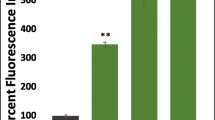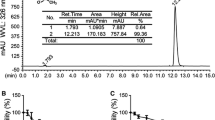Abstract
Breast cancer is an invasive malignant neoplasm; however, an increasing number of naturally occurring chemical compounds have been identified as potent cytotoxic agents. Kadsura coccinea (Lem.) A.C.Sm., Schisandraceae, is a medicinally important Chinese plant. Schisandronic acid, a cycloartane triterpenoid, is a major cytotoxic compound from this plant. The mechanisms behind the cytotoxic potential of schisandronic acid against a human breast carcinoma cell line were evaluated by employing cell viability assay using MTT and western blot analysis. Antioxidant capacity was measured by employing luminol- and lucigenin-enhanced chemiluminescence assays. Schisandronic acid was able to induce cell apoptosis in MCF-7 cells in a time-dependent manner. This triterpenoid significantly reduced cell viability in a concentration-dependent manner with an IC50 value of 8.06 ± 1.119 μM. The mechanisms might be mediated through upregulation of the expression of active caspase-3, and cleavage of poly (ADP-ribose) polymerase. Furthermore, schisandronic acid was investigated for its antioxidant effects and shown reduced generation of reactive oxygen species.
Graphical abstract





Similar content being viewed by others
References
Babior BM (2004) NADPH oxidase. Curr Opin Immunol 16:42–47. https://doi.org/10.1016/j.coi.2003.12.001
Cao L, Shehla N, Tasneem S, Cao M, Sheng W, Jian Y, Li B, Peng C, Choudhary MI, Liao DF, Wang W (2020) Kadsura coccinea: a rich source of structurally diverse and biologically important compounds. Chinese Herbal Medicines 12:214–223. https://doi.org/10.3390/molecules24091664
Chen Y-G, Wu Z-C, Lv Y-P, Gui S-H, Wen J, Liao X-R, Yuan LM, Halaweish F (2003) Triterpenoids from Schisandra henryi with cytotoxic effect on leukemia and hela cellsin vitro. Arch Pharm Res 26:912–916. https://doi.org/10.1007/BF02980199
Droge W (2002) Free radicals in the physiological control of cell function. Physiol Rev 82:47–95. https://doi.org/10.1152/physrev.00018.2001
Gao X-M, Pu J-X, Xiao W-L, Huang S-X, Lou L-G, Sun H-D (2008) Kadcoccilactones K–R, triterpenoids from Kadsura coccinea. Tetrahedron 64:11673–11679. https://doi.org/10.1021/np800078x
Gornstein E, Schwarz TL (2014) The paradox of paclitaxel neurotoxicity: mechanisms and unanswered questions. Neuropharmacology 76:75–183. https://doi.org/10.1016/j.neuropharm.2013.08.016
Hermawan A, Putri H (2018) Current report of natural product development against breast cancer stem cells. Int J Biochem Cell Biol 104:114–132. https://doi.org/10.1016/j.biocel.2018.09.012
Kovacic P, Jacintho JD (2001) Mechanisms of carcinogenesis: focus on oxidative stress and electron transfer. Curr Med Chem 8:773–796. https://doi.org/10.2174/0929867013373084
Liu J, Qi Y, Lai H, Zhang J, Jia X, Liu H, Zhang B, Xiao P (2014) Genus Kadsura, a good source with considerable characteristic chemical constituents and potential bioactivities. Phytomedicine 21:1092–1097. https://doi.org/10.1016/j.phymed.2014.01.015
Liu Y, Yang Y, Tasneem S, Hussain N, Daniyal M, Yuan H, Xie Q, Liu B, Sun J, Jian Y, Li B, Chen S, Wang W (2018) Lignans from Tujia Ethnomedicine Heilaohu: chemical characterization and evaluation of their cytotoxicity and antioxidant activities. Molecules 23:2147. https://doi.org/10.3390/molecules23092147
Maeda S, Kamata H, Luo J-L, Leffert H, Karin M (2005) IKKβ couples hepatocyte death to cytokine-driven compensatory proliferation that promotes chemical hepatocarcinogenesis. Cell 121:977–990. https://doi.org/10.1016/j.cell.2005.04.014
Pikarsky E, Porat RM, Stein I, Abramovitch R, Amit S, Kasem S, Gutkovich-Pyest E, Urieli-Shoval S, Galun E, Ben-Neriah Y (2004) NF-κB functions as a tumour promoter in inflammation-associated cancer. Nature 431:461. https://doi.org/10.1038/nature02924
Prasad S, Gupta SC, Pandey MK, Tyagi AK, Deb L (2016) Oxidative stress and cancer: advances and challenges. Oxid Med Cell Longev. https://doi.org/10.1155/2016/5010423
Sanchez-Vega F, Mina M, Armenia J, Chatila WK, Luna A, La KC, Dimitriadoy S, Liu DL, Kantheti HS, Saghafinia S, Chakravarty D (2018) Oncogenic signaling pathways in the cancer genome atlas. Cell 173:321–337. https://doi.org/10.1016/j.cell.2018.03.035
Sharifi S, Barar J, Hejazi MS, Samadi N (2014) Roles of the Bcl-2/Bax ratio, caspase-8 and 9 in resistance of breast cancer cells to paclitaxel. Asian Pac J Cancer Prev 15:8617–8622. https://doi.org/10.7314/APJCP.2014.15.20.8617
Shi Y-M, Xiao W-L, Pu J-X, Sun H-D (2015) Triterpenoids from the Schisandraceae family: an update. Nat Prod Rep 32:367–410. https://doi.org/10.1039/C4NP00117F
Sibaud V, Lebœuf NR, Roche H, Belum VR, Gladieff L, Deslandres M, Montastruc M, Eche A, Vigarios E, Dalenc F, Lacouture ME (2016) Dermatological adverse events with taxane chemotherapy. Eur J Dermatol 26:427–443. https://doi.org/10.1684/ejd.2016.2833
Siegel R, Naishadham D, Jemal A (2012) Cancer statistics for hispanics/latinos, 2012. CA: a cancer journal for clinicians 62(5):283–298. https://doi.org/10.3322/caac.20138
Tarpey MM, Fridovich I (2001) Methods of detection of vascular reactive species: nitric oxide, superoxide, hydrogen peroxide, and peroxynitrite. Circ Res 89:224–236. https://doi.org/10.1161/hh1501.09436
Teponno RB, Kusari S, Spiteller M (2016) Recent advances in research on lignans and neolignans. Nat Prod Rep 33:1044–1092. https://doi.org/10.1039/C6NP00021E
Wang W, Liu J, Han J, Xu Z, Liu R, Liu P, Wang W, Ma X, Guan S, Guo D (2006) New triterpenoids from Kadsura heteroclita and their cytotoxic activity. Planta Med 72:450–457. https://doi.org/10.1055/s-2005-916263
Wang G-W, Deng L-Q, Luo Y-P, Liao Z-H, Chen M (2017) Hepatoprotective triterpenoids and lignans from the stems of Schisandra pubescens. Nat Prod Res:311855–311860. https://doi.org/10.1080/14786419.2016.1261348
Xu L-J, Huang F, Chen S-B, Zhang Q-X, Li L-N, Chen S-L, Xiao P-G (2006) New lignans and cytotoxic constituents from Schisandra propinqua. Planta Med 72:169–174. https://doi.org/10.1055/s-2005-873199
Funding
Financial support was provided by the Hunan Province Universities 2011 collaborative Innovation Center of Protection and Utilization of Huxiang Chinese Medicine Resources, Hunan Provincial Key Laboratory of Diagnostics in Chinese Medicine and National Natural Science Foundation of China (81673579 and 81874369), Talented Young Scientist Program for developing countries, Ministry of Science and Technology, China, and Shaanxi innovative talents promotion plan and technological innovation team (2018TD-005).
Author information
Authors and Affiliations
Contributions
Biological evaluations and writing of the manuscript: ST; chemical analysis as well as writing the chemistry part: YY; supervision of all activities and biological assays: BL; preparation of the whole project and chemical analysis: MIC; design of the study, provision of plant material, supervision of the whole project and critical review of the manuscript: WW; all authors have approved the final article.
Corresponding authors
Ethics declarations
Conflict of Interest
The authors declare no competing interests.
Supplementary Information
ESM 1
(PDF 646 kb)
Rights and permissions
About this article
Cite this article
Tasneem, S., Yang, Y., Liu, B. et al. Cytotoxicity of Schisandronic Acid from Kadsura coccinea by Activation of Caspase-3, Cleavage of poly-ADP Ribose Polymerase, and Reduction of Oxidative Stress. Rev. Bras. Farmacogn. 31, 51–58 (2021). https://doi.org/10.1007/s43450-021-00136-7
Received:
Accepted:
Published:
Issue Date:
DOI: https://doi.org/10.1007/s43450-021-00136-7




